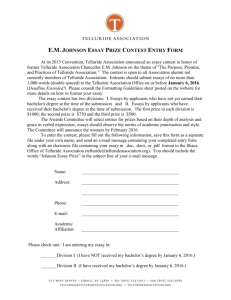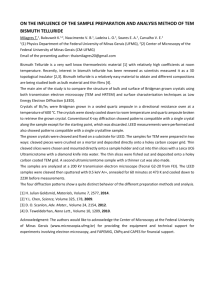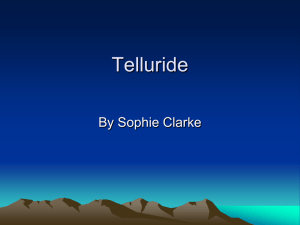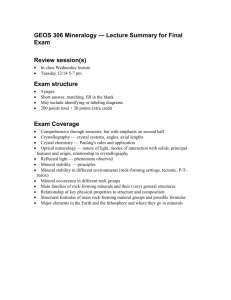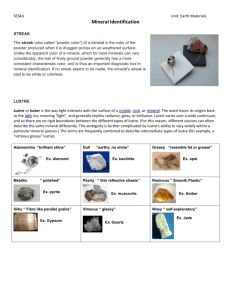SYLVANITE - Cuyuna Rock, Gem and Mineral Society
advertisement
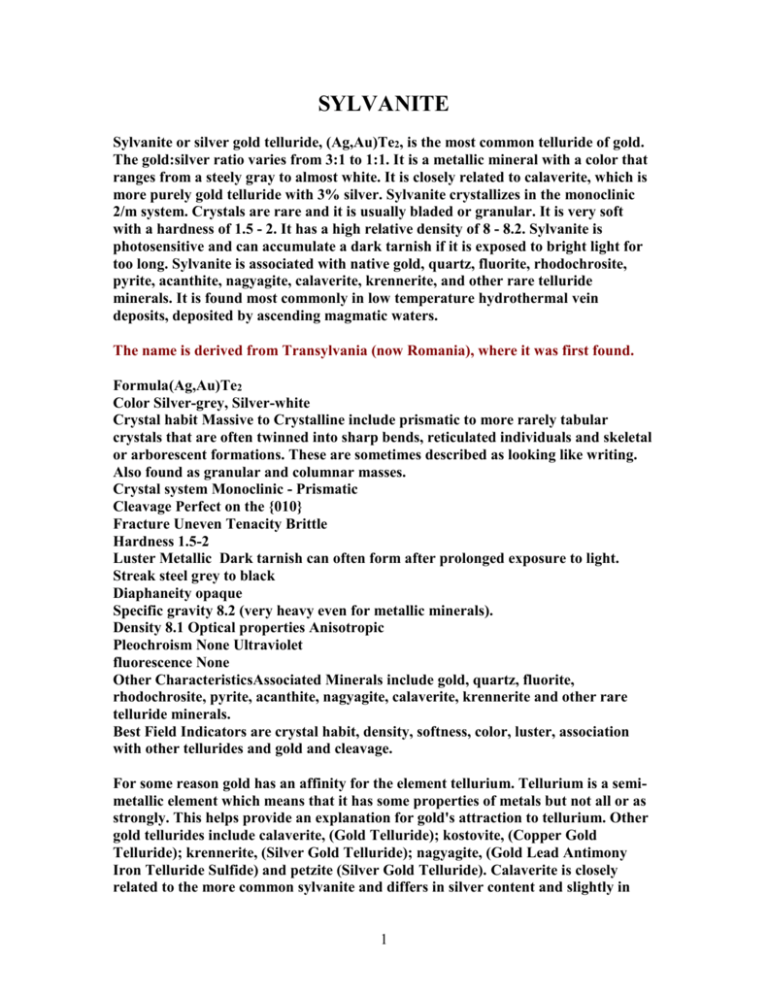
SYLVANITE
Sylvanite or silver gold telluride, (Ag,Au)Te2, is the most common telluride of gold.
The gold:silver ratio varies from 3:1 to 1:1. It is a metallic mineral with a color that
ranges from a steely gray to almost white. It is closely related to calaverite, which is
more purely gold telluride with 3% silver. Sylvanite crystallizes in the monoclinic
2/m system. Crystals are rare and it is usually bladed or granular. It is very soft
with a hardness of 1.5 - 2. It has a high relative density of 8 - 8.2. Sylvanite is
photosensitive and can accumulate a dark tarnish if it is exposed to bright light for
too long. Sylvanite is associated with native gold, quartz, fluorite, rhodochrosite,
pyrite, acanthite, nagyagite, calaverite, krennerite, and other rare telluride
minerals. It is found most commonly in low temperature hydrothermal vein
deposits, deposited by ascending magmatic waters.
The name is derived from Transylvania (now Romania), where it was first found.
Formula(Ag,Au)Te2
Color Silver-grey, Silver-white
Crystal habit Massive to Crystalline include prismatic to more rarely tabular
crystals that are often twinned into sharp bends, reticulated individuals and skeletal
or arborescent formations. These are sometimes described as looking like writing.
Also found as granular and columnar masses.
Crystal system Monoclinic - Prismatic
Cleavage Perfect on the {010}
Fracture Uneven Tenacity Brittle
Hardness 1.5-2
Luster Metallic Dark tarnish can often form after prolonged exposure to light.
Streak steel grey to black
Diaphaneity opaque
Specific gravity 8.2 (very heavy even for metallic minerals).
Density 8.1 Optical properties Anisotropic
Pleochroism None Ultraviolet
fluorescence None
Other CharacteristicsAssociated Minerals include gold, quartz, fluorite,
rhodochrosite, pyrite, acanthite, nagyagite, calaverite, krennerite and other rare
telluride minerals.
Best Field Indicators are crystal habit, density, softness, color, luster, association
with other tellurides and gold and cleavage.
For some reason gold has an affinity for the element tellurium. Tellurium is a semimetallic element which means that it has some properties of metals but not all or as
strongly. This helps provide an explanation for gold's attraction to tellurium. Other
gold tellurides include calaverite, (Gold Telluride); kostovite, (Copper Gold
Telluride); krennerite, (Silver Gold Telluride); nagyagite, (Gold Lead Antimony
Iron Telluride Sulfide) and petzite (Silver Gold Telluride). Calaverite is closely
related to the more common sylvanite and differs in silver content and slightly in
1
hardness, cleavage, color and density. At times the two minerals are only
distinguishable with chemical tests.
Crystals of sylvanite are unique and of interest to collectors. Typically found as
prisms that can be twinned causing sharp bends, reticulated individuals and skeletal
or arborescent formations. These clusters remind many collectors of writing.
In crystallization sylvanite is isomorphous with calaverite. Its crystals are usually
rich in planes, about 75 having been identified. Their habit is usually tabular. The
mineral also occurs in skeleton crystals and in aggregates that are platy or granular.
Twinning is common.
Sylvanite is easily fusible with a blow pipe at (1). If a little of the powdered mineral
is heated in concentrated sulphuric acid the solution assumes a deep red color (an
indication of tellurium). When decomposed in nitric acid leaves a rusty-colored,
spongy mass of gold, and the solution with hydrochloric acid gives white precipitate
of silver chloride. When heated with sodium carbonate on charcoal it gives a globule
of gold and silver. Sylvanite is determined, by the above tests, by its silver color and
good cleavage. Its chemical properties are the same as those of calaverite, but the
silver precipitate produced by adding HC1 to its solution in HNO3 is always large. It
is best distinguished from the gold telluride by its cleavage and from Petzite
((Ag,Au)2Te) and kessite (Ag2Te) by its crystallization, and by the yellow metallic
globule produced when the mineral is roasted on charcoal. It is distinguishable from
krennerite by its crystallization.
Localities and Origin. Sylvanite is a rare mineral, and is found with gold ores and
the other tellurides in veins at Offenbanya and Nagyag in Romania, in the mines at
Cripple Creek and in Boulder Co., Colorado, near Kalgoorlie, Western Australia, in
small quantities near Balmoral in the Black Hills, S.D., and at Moss, near Thunder
Bay, Ontario. Like calaverite it was deposited by ascending magmatic waters, or by
hot vapors. It is mined with calaverite as a gold and silver ore at Cripple Creek and
in Boulder Co., Colorado.
2
SYLVANITE
Harry A. Wagoner
3
CALAVERITE
Calaverite is an uncommon telluride of gold, a metallic mineral with the chemical
formula AuTe2, with approximately 3% of the gold replaced by silver.
The mineral often has a metallic luster, and its color may range from a silvery white
to a brassy yellow. It is closely related to the gold-silver telluride mineral sylvanite,
which, however, contains significantly more silver. Another AuTe2 mineral (but
with a quite different crystal structure) is krennerite. Calaverite and sylvanite
represent the major telluride ores of gold, although such ores are minor sources of
gold in general.
Calaverite occurs as monoclinic crystals, which do not possess cleavage planes.
Calaverite’s structure has been both an object of fascination and frustration in the
scientific community for many years. Goldschmidt et al. indexed calaverite 105
crystals resulting in 92 forms but needed five different lattices to index all of the
faces. This led to consideration that calaverite violated Haüy's Law of Rational
Indices.
The introduction of X-ray diffraction did not completely solve this problem. Tunell
and Ksanda in 1936 and then Tunell and Pauling in 1952 solved the C2/m general
structure of calaverite. However, additional diffraction spots which they could not
interpret were present in the survey. Later, transmission electron microscopy study
suggested that the satellite reflections in calaverite were due to Au in
commensurately displacive modulation superimposed on the average C2/m
structure. In 1988, Schutte and DeBoer solved the structure by using the 3H super
space group C2/m (α O γ)Os. They also showed that these modulations consist
mainly of the displacements of tellurium atoms and the observed modulations were
interpreted in terms of valence fluctuations between the Au+ and Au3+. According to
Schutte and DeBoer, those displacements also affect the coordination number of
calaverite.
In 2009, Bindi et al. concluded that the different coordination numbers associated
with calaverite were indeed associated with a significant differentiation in the
valence sum of Au, and that the random distribution of Ag suppresses the
fluctuation of Au+ and Au3+, whereas the ordered distribution reinforces it.
Calaverite was first recognized and obtained in 1861 from the Stanislaus Mine,
Carson Hill, Angels Camp, in Calaveras Co., California. It was named for the
County of origin by chemist and mineralogist Frederick Augustus Genth who
differentiated it from the known gold telluride mineral sylvanite, and formally
4
reported it as a new gold mineral in 1868. Genth found that the telluride formula for
calaverite generally corresponded with the gold-silver telluride mineral sylvanite,
but had a far lower percentage of ionic silver in place of ionic gold (3 to 3.5% in
Genth's analysis, vs. 11 to 13% silver typical for sylvanite). Since silver is
isomorphic with gold in telluride minerals (i.e. gold atoms replace silver without
automatically changing the crystal character), Genth more importantly reported the
calaverite differed from sylvanite in having no distinct crystalline cleavage line,
whereas sylvanite was known to have a distinct line of cleavage. (As discussed above,
both sylvanite and calaverite have since been found to be basically monoclinic,
whereas the third known gold-silver telluride mineral krennerite is orthorhombic,
with yet a different characteristic line of cleavage parallel to the crystal base). Genth
was later also able to characterize a sample of calaverite from Boulder, Colorado,
finding that his two specimens from that location were 2.04 and 3.03% silver.
Calaverite is typically found as striated prisms that can be twinned causing sharp
bends, reticulated individuals and skeletal or arborescent formations. These clusters
remind many collectors of writing.
Formula - AuTe2
Crystal symmetry- Monoclinic prismatic 2/m Unit cell a = 7.
Color- Brass yellow to silver white
Crystal habit- Bladed and slender striated prisms, also massive granular
Crystal system -Monoclinic Twinning Common on [110]
Cleavage- None
Fracture -Uneven to subconchoidal Tenacity Brittle
Hardness -2.5-3
Luster- Metallic
Streak -Green to yellow grey
Diaphaneity -Opaque
Specific gravity -9.1-9.3
Optical properties - Anisotropic
Pleochroism - Weak Ultraviolet
Fluorescence-None
Other Characteristics: Crystals tend to be deeply striated parallel to the prominent
length.
Best Field Indicators are crystal habit, density, softness, color, luster, association
with other tellurides and gold and lack of cleavage.
In the initial phase of the Kalgoorlie gold rush in Western Australia in 1893, large
amounts of calaverite were initially mistaken for fool's gold, and were discarded.
The mineral deposits were used as a building material, and for the filling of potholes
and ruts. Several years later, the nature of the mineral was identified, leading to a
second gold rush of 1896 that included excavating the town's streets.
5
Calaverite occurrences include Cripple Creek, Colorado, Calaveras County,
California, USA (from where it gets its name), Nagyag, Romania, Kirkland Lake
Gold District, Ontario, Rouyn District, Quebec, and Kalgoorlie, Australia.
CALAVERITE
Harry A. Wagoner
6
